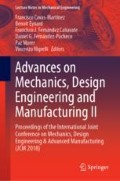Abstract
In the speed-based competition, with the use of fast vehicles, a fundamental aspect is the safety and comfort of the drivers. In each speed-based competition, the drivers are subjected to vibrations and stresses whose evaluation is fundamental in order to quantify the discomfort of them. The comfort conditions are guaranteed by a deep study of the correct size of the internal spaces, the right posture of the drivers and the right choice of the position of the elements inside the vehicles (damping elements, position of the steering wheel, position of instruments, etc.). Another important aspect is the assessment of the escape spaces in case of accident. To reach these goals, the Governing Body act with the definition and the verification of technical rules. In this work the field of interest is powerboats sport. During the powerboat race, the reached speed and the z-acceleration of the boat lead to several stresses on drivers. Two different approaches have been investigated, a traditional 2D approach and an innovative 3D approach. Results have been discussed.
Access this chapter
Tax calculation will be finalised at checkout
Purchases are for personal use only
References
Owen N, King H, Lamb M (2015) Literature review of race driver fatigue measurement in endurance motorsport. Procedia Eng 112:344–348. https://doi.org/10.1016/j.proeng.2015.07.260
Cucinotta F, Guglielmino E, Risitano G, Sfravara F (2016) Assessment of damage evolution in sandwich composite material subjected to repeated impacts by means optical measurements. Procedia Struct Integr 2:3660–3667. https://doi.org/10.1016/j.prostr.2016.06.455
Cucinotta F, Paoli A, Risitano G, Sfravara F (2018) Optical measurements and experimental investigations in repeated low-energy impacts in powerboat sandwich composites. Proc Inst Mech Eng Part M J Eng Marit Environ 232:234–244. https://doi.org/10.1177/1475090217720619
Van Nueten J (2014) Offshore powerboat rescue, In: Drowning, Springer Berlin Heidelberg, Berlin, Heidelberg, pp 505–508. https://doi.org/10.1007/978-3-642-04253-9_77
Cucinotta F, Guglielmino E, Sfravara F (2017) Frequency of ship collisions in the strait of messina through regulatory and environmental constraints assessment. J Navig 1–21. https://doi.org/10.1017/s0373463317000157
Kamp I (2012) The influence of car-seat design on its character experience. Appl Ergon 43:329–335. https://doi.org/10.1016/j.apergo.2011.06.008
Ebe K, Griffin MJ (2000) Qualitative models of seat discomfort including static and dynamic factors. Ergonomics 43:771–790. https://doi.org/10.1080/001401300404742
El Falou W, Duchêne J, Grabisch M, Hewson D, Langeron Y, Lino F (2003) Evaluation of driver discomfort during long-duration car driving. Appl Ergon 34:249–255. https://doi.org/10.1016/S0003-6870(03)00011-5
Makhsous M, Hendrix R, Crowther Z, Nam E, Lin F (2005) Reducing whole-body vibration and musculoskeletal injury with a new car seat design. Ergonomics 48:1183–1199. https://doi.org/10.1080/00140130500226903
Kaul A, Abbas A, Smith G, Manjila S, Pace J, Steinmetz M (2016) A revolution in preventing fatal craniovertebral junction injuries: lessons learned from the head and neck support device in professional auto racing. J Neurosurg Spine 25:756–761. https://doi.org/10.3171/2015.10.SPINE15337
Kumar Sharma H, Singhal P, Sonia P (2018) Computer-assisted industrial ergonomics: a review. pp 37–48. https://doi.org/10.1007/978-981-10-5457-0_4
Kajaks T, Vrkljan B, MacDermid J, Godwin A (2016) Using simulation to better understand the effects of aging on driver visibility. Can J Aging/La Rev Can Du Vieil 35:110–116. https://doi.org/10.1017/s0714980816000106
Reed MP, Raschke U, Tirumali R, Parkinson MB (2014) Developing and implementing parametric human body shape models in ergonomics software. In: proceedings of the 3rd international digital human modeling conference pp 1–8
Pheasant S Haslegrave CM (2005) Bodyspace: anthropometry. Ergonomics and the design of work. Third Edit
Schmidt S, Amereller M, Franz M, Kaiser R, Schwirtz A (2014) A literature review on optimum and preferred joint angles in automotive sitting posture. Appl Ergon 45:247–260. https://doi.org/10.1016/j.apergo.2013.04.009
Andreoni G, Santambrogio GC, Rabuffetti M, Pedotti A (2002) Method for the analysis of posture and interface pressure of car drivers. Appl Ergon 33:511–522. https://doi.org/10.1016/S0003-6870(02)00069-8
Acknowledgments
The authors wish to thank the Union Internationale Motonautique for providing the information, Sebastiano Pellecchia and Roberto Lo Piano for the precious comments and suggestions and Marcello Raffaele and Fabio Salmeri for the irreplaceable help in 3D modeling and image analysis.
Author information
Authors and Affiliations
Corresponding author
Editor information
Editors and Affiliations
Rights and permissions
Copyright information
© 2019 Springer Nature Switzerland AG
About this paper
Cite this paper
Abrami, S., Cucinotta, F., Guglielmino, E., Sfravara, F. (2019). Human Factors Assessment for Comfort and Safety in the XCAT Powerboats Rules. In: Cavas-Martínez, F., Eynard, B., Fernández Cañavate, F., Fernández-Pacheco, D., Morer , P., Nigrelli, V. (eds) Advances on Mechanics, Design Engineering and Manufacturing II. Lecture Notes in Mechanical Engineering. Springer, Cham. https://doi.org/10.1007/978-3-030-12346-8_4
Download citation
DOI: https://doi.org/10.1007/978-3-030-12346-8_4
Published:
Publisher Name: Springer, Cham
Print ISBN: 978-3-030-12345-1
Online ISBN: 978-3-030-12346-8
eBook Packages: EngineeringEngineering (R0)

